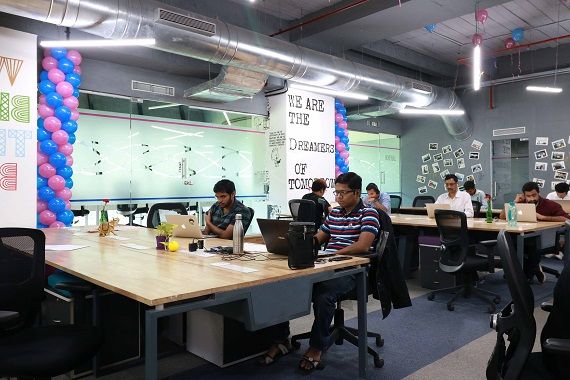A survey conducted by Staples.com revealed a startling result, “41% of workers preferred that they have no office at all!” Office space is probably one of the biggest investments companies make, and such an overwhelming preference among today’s workforce for doing away with the office throws up several questions about traditional workspaces.
Companies are increasingly investing heavily in activities designed to foster team spirit and collaboration. The savvy HR manager knows that a weekend rock climbing trip or a Diwali party, while having no tangible impact on the company’s profits, has immeasurable benefits in fostering company spirit and camaraderie between employees, thereby building strong teams which know how to collaborate productively and work towards a common goal.
But are we investing the same amount of time and resources towards a very important component of a positive work environment—the office itself? Workplaces overwhelmingly tend to be drab uninspiring spaces, almost as if they were designed with a cookie cutter mould. Needless to say, a space like this overwhelmingly creates negative feelings among workers, and is hardly conducive for inspired and creative work output.
Steelcase identifies three major factors which help in transforming an uninspiring workspace into one better suited for innovation and creative collaboration between its employees—1)culture, 2)technology and tools, and 3)process. Imbuing these three factors into the office space in the right manner will help foster a workspace which works hard as its employees do in achieving results for the company.
So what are the ways in which one can create the optimal work environment for one’s employees? Here are some suggestions:
- Team is key: Steelcase, in its white paper on workspace optimization, says–“The myth of the lone genius achieving one eureka after another in a closed room is a cartoonish, outdated cliché. There’s growing understanding that real breakthrough comes from people doing the hard work of innovation together, mixing their ideas in a bouillabaisse of insights and laddered thinking.” The typical workplace isolates employees in individual cubicles, and collaborative attempts are almost always forced. We should aim to create space for unstructured free collaboration and brainstorming. Freely accessible conference rooms designed to seat 5-8 people, or a lively break room with the availability of reasonably priced food are great options to create a more informal space within an office, where ideas can flow freely. For companies spread over different geographies, it might be useful to set up an intra-company messenger service, or message board, for the free exchange of ideas on projects.
- Adopted by Large Enterprise: Top companies the world over, like Google and Facebook, are moving away from hierarchies, and aiming instead to create networks. This is a good philosophy to have for any workplace. One should do away with earmarking office space based on designation, like the infamous corner office, and seek to create a more egalitarian space. Senior employees can benefit from fresh ideas and outlooks which newer employees bring in, while providing the latter with the benefit of their vast experience and time-tested tricks of trade.
- Private space is equally important: While it is always a good idea to eradicate communication barriers, both physical and otherwise, so as not to hinder a free flow of ideas between employees, sometimes this can prove counterproductive, with constant interruptions from co-workers while working on a project. Ensure that employees have access to a private space to work uninterrupted in quiet. This will boost productivity, as the workplace caters to employees of all dispositions, from extroverted individuals who thrive with constant social stimulation, to introverts who require some amount of privacy. The key here is to allow for employees to set structures, and facilitate free collaboration without it being an imposition. The great inventor, Thomas Alva Edison, designated a private space for himself to work in, but had an open door policy for all his employees. This approach ensured that Edison’s Menlo Park Laboratory had a whopping 1,093 US patents to its credit!
- Mind and colours: Colours play an important role in influencing psyche. Blue is said to have a calming effect, while yellow boosts energy, and red increases aggression. A judicious use of colours in the workplace can work wonders to create the right work environment. Using colours and images associated with the company’s brand is very pertinent as well, when most companies are looking at loyalty as a huge productivity booster. Office stationery and supplies can play a part here as well, and quirky bright office supplies are universally found to increase employee engagement with the workplace and company’s brand. For example, coffee mugs in Penguin Inc. have puns about their popular titles embossed on them, creating awareness about the company’s product and increasing employee engagement in a humourous, non-pushy way.
These are times when pressure is piling on companies to stay ahead of the competition, and yet minimize expenditure to the furthest possible extent. Creating inspired free plan workplaces leads to happier workers and boosts innovation and productivity—a win-win situation for both employer and employees.
